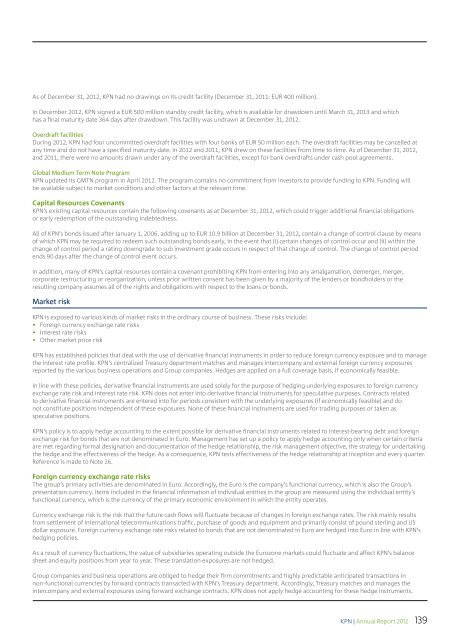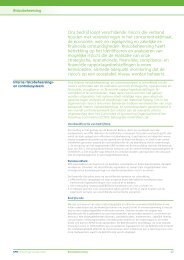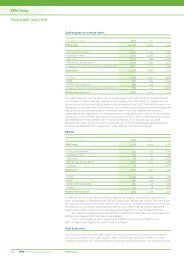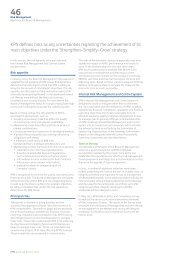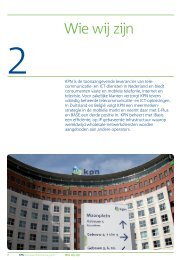FINANCIAL STATEMENTS - KPN
FINANCIAL STATEMENTS - KPN
FINANCIAL STATEMENTS - KPN
You also want an ePaper? Increase the reach of your titles
YUMPU automatically turns print PDFs into web optimized ePapers that Google loves.
As of December 31, 2012, <strong>KPN</strong> had no drawings on its credit facility (December 31, 2011: EUR 400 million).<br />
In December 2012, <strong>KPN</strong> signed a EUR 500 million standby credit facility, which is available for drawdown until March 31, 2013 and which<br />
has a final maturity date 364 days after drawdown. This facility was undrawn at December 31, 2012.<br />
Overdraft facilities<br />
During 2012, <strong>KPN</strong> had four uncommitted overdraft facilities with four banks of EUR 50 million each. The overdraft facilities may be cancelled at<br />
any time and do not have a specified maturity date. In 2012 and 2011, <strong>KPN</strong> drew on these facilities from time to time. As of December 31, 2012,<br />
and 2011, there were no amounts drawn under any of the overdraft facilities, except for bank overdrafts under cash pool agreements.<br />
Global Medium Term Note Program<br />
<strong>KPN</strong> updated its GMTN program in April 2012. The program contains no commitment from investors to provide funding to <strong>KPN</strong>. Funding will<br />
be available subject to market conditions and other factors at the relevant time.<br />
Capital Resources Covenants<br />
<strong>KPN</strong>’s existing capital resources contain the following covenants as at December 31, 2012, which could trigger additional financial obligations<br />
or early redemption of the outstanding indebtedness.<br />
All of <strong>KPN</strong>’s bonds issued after January 1, 2006, adding up to EUR 10.9 billion at December 31, 2012, contain a change of control clause by means<br />
of which <strong>KPN</strong> may be required to redeem such outstanding bonds early, in the event that (i) certain changes of control occur and (ii) within the<br />
change of control period a rating downgrade to sub investment grade occurs in respect of that change of control. The change of control period<br />
ends 90 days after the change of control event occurs.<br />
In addition, many of <strong>KPN</strong>’s capital resources contain a covenant prohibiting <strong>KPN</strong> from entering into any amalgamation, demerger, merger,<br />
corporate restructuring or reorganization, unless prior written consent has been given by a majority of the lenders or bondholders or the<br />
resulting company assumes all of the rights and obligations with respect to the loans or bonds.<br />
Market risk<br />
<strong>KPN</strong> is exposed to various kinds of market risks in the ordinary course of business. These risks include:<br />
ýý<br />
Foreign currency exchange rate risks<br />
ýý<br />
Interest rate risks<br />
ýý<br />
Other market price risk<br />
<strong>KPN</strong> has established policies that deal with the use of derivative financial instruments in order to reduce foreign currency exposure and to manage<br />
the interest rate profile. <strong>KPN</strong>’s centralized Treasury department matches and manages intercompany and external foreign currency exposures<br />
reported by the various business operations and Group companies. Hedges are applied on a full coverage basis, if economically feasible.<br />
In line with these policies, derivative financial instruments are used solely for the purpose of hedging underlying exposures to foreign currency<br />
exchange rate risk and interest rate risk. <strong>KPN</strong> does not enter into derivative financial instruments for speculative purposes. Contracts related<br />
to derivative financial instruments are entered into for periods consistent with the underlying exposures (if economically feasible) and do<br />
not constitute positions independent of these exposures. None of these financial instruments are used for trading purposes or taken as<br />
speculative positions.<br />
<strong>KPN</strong>’s policy is to apply hedge accounting to the extent possible for derivative financial instruments related to interest-bearing debt and foreign<br />
exchange risk for bonds that are not denominated in Euro. Management has set up a policy to apply hedge accounting only when certain criteria<br />
are met regarding formal designation and documentation of the hedge relationship, the risk management objective, the strategy for undertaking<br />
the hedge and the effectiveness of the hedge. As a consequence, <strong>KPN</strong> tests effectiveness of the hedge relationship at inception and every quarter.<br />
Reference is made to Note 26.<br />
Foreign currency exchange rate risks<br />
The group’s primary activities are denominated in Euro. Accordingly, the Euro is the company’s functional currency, which is also the Group’s<br />
presentation currency. Items included in the financial information of individual entities in the group are measured using the individual entity’s<br />
functional currency, which is the currency of the primary economic environment in which the entity operates.<br />
Currency exchange risk is the risk that the future cash flows will fluctuate because of changes in foreign exchange rates. The risk mainly results<br />
from settlement of international telecommunications traffic, purchase of goods and equipment and primarily consist of pound sterling and US<br />
dollar exposure. Foreign currency exchange rate risks related to bonds that are not denominated in Euro are hedged into Euro in line with <strong>KPN</strong>’s<br />
hedging policies.<br />
As a result of currency fluctuations, the value of subsidiaries operating outside the Eurozone markets could fluctuate and affect <strong>KPN</strong>’s balance<br />
sheet and equity positions from year to year. These translation exposures are not hedged.<br />
Group companies and business operations are obliged to hedge their firm commitments and highly predictable anticipated transactions in<br />
non-functional currencies by forward contracts transacted with <strong>KPN</strong>’s Treasury department. Accordingly, Treasury matches and manages the<br />
intercompany and external exposures using forward exchange contracts. <strong>KPN</strong> does not apply hedge accounting for these hedge instruments.<br />
<strong>KPN</strong> | Annual Report 2012 139


